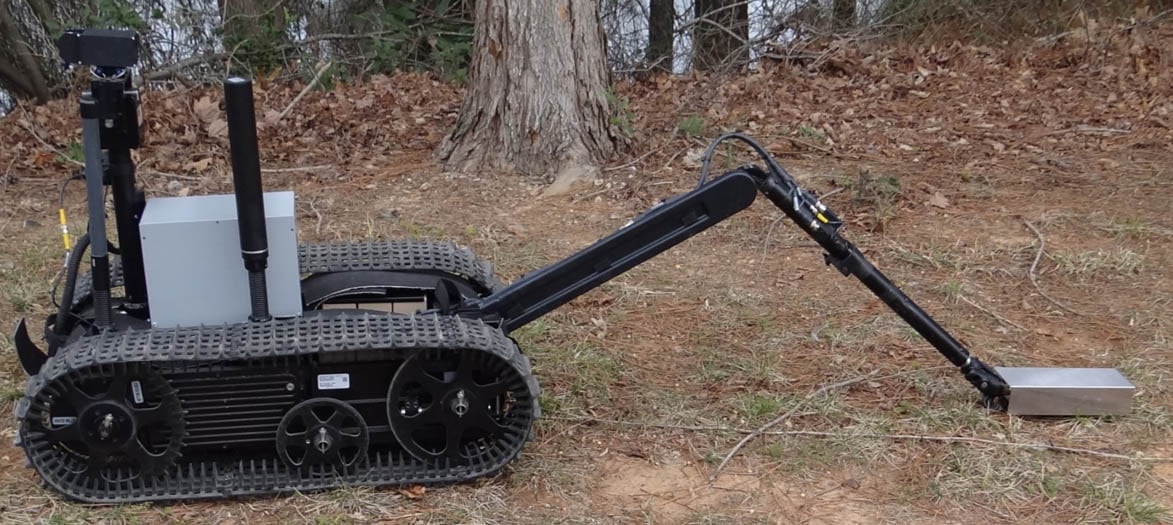A new method of detecting landmines could drastically reduce time-consuming false alarms and keep EOD soldiers from having to dig up every target that triggers their detectors.
Army Times spoke recently with Jim Harvey, program manager at the Army Research Office, part of the Combat Capabilities Development Command about the new technology.
“In a typical minefield, there may be 100 to 1,000 false alarms for every detected mine,” Harvey and his co-authors wrote in a research paper published in the “Proceedings” journal.
Those false alarms eat up valuable operations time but are a necessity, because if one false alarm proves true, people might die.
The results of the Army’s work are likely to have implications for Navy, Air Force and Marine Corps EODs.
What Harvey and his team have shown in work at the Army Research Lab is that they can use certain frequencies to vibrate metal parts inside of a landmine. Those vibrations are then measured and deciphered by the equipment.
That way, the explosive ordnance disposal crews, or soldiers using common detectors in the future, can sift through the detritus underground and know if what they’re about to step on could blow.
Harvey began his Army career, from the early 1960s to the mid-1980s, as a field artillery officer, then moved over to the signal corps.
Over time he became more involved in the technical jobs, especially those working with lasers and electronics.
Since the early 1990s, he’s been with the Army Research Office.
The metal vibration work for landmine detection has shown success in the lab. The next steps will focus on miniaturizing and ruggedizing the hardware and getting it into the field.
But a lot will depend on better signal processing, Harvey said.

“We’ve had really good results with a crude ‘if you see it and it looks like a target, then we’re sure it’s a target,’ ” he said. “Then we have to pull that from a more noisy signal. That can be challenging.”
The project is working through a small business called Vadum and has dubbed the system VENUS, Vibration Enhanced Underground Sensing System.
The goal is to have the capability layered atop existing man-portable detection systems, but that might be a few years off, he said.
Harvey estimates that a soldier-portable battery-powered system could be about three years off.
An infantryman could carry it with him, alongside a buddy. When he finds a target, he can keep going and he can take maybe 10 seconds to get confirmation one way or another, he said.
Handheld options could also be attached to robots to do the exploration for the soldier.
“The challenges are of an engineering and design nature,” Harvey said, “getting a good package and making sure that, because it’s a pulse system, it doesn’t take continuous electrical current, it takes pulse current.”
While improvised explosive devices dotted the battlefields of the past decades and will continue to do so, Army planners with an eye on large scale combat operations are focusing on route clearance and massive minefields as barriers.
“This will speed up road clearance,” Harvey said. “If you’re moving tactically with an armored force, as long as you’re staying in your vehicle, it’s not hard to find the big, anti-tank mines. But those systems are not as sensitive to small, antipersonnel mines.”
That’s why adversaries use them, to slow up large formations and force soldiers to dismount to find them, which makes units more vulnerable to attack.
“Doing that channelizes you, from a tactical point of view, if you’re a terrorist you just want to kill people and destroy things, but if you’re a defending infantry officer, you want to channelize people and then target them with artillery.”
Todd South has written about crime, courts, government and the military for multiple publications since 2004 and was named a 2014 Pulitzer finalist for a co-written project on witness intimidation. Todd is a Marine veteran of the Iraq War.




